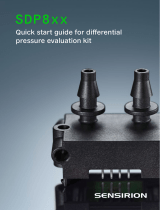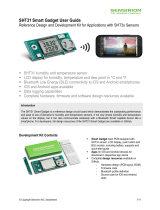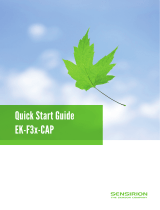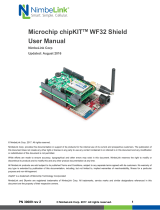SENSIRION SENSEVAL-SHT4XV1 Reference guide
- Type
- Reference guide

Introduction
This technical note provides a high-level reference to guide the user in replacing the HTS221 humidity sensor with sensors from
the SHT4x family from Sensirion and outlines important differences to be considered in the design-in processes. Table 1 below
summarizes the features and key differences.
Table 1. Key differences
Parameter HTS221 SHT4x
Dimensions (mm3)2.0 x 2.0 x 0.9 1.5 x 1.5 x 0.5
Pin assignment 6-pin HLGA package 4-pin DFN package
Interface SPI and I²C, single address I²C, multiple addresses
Supply voltage (V) 1.7 – 3.6 1.08 – 3.6
Average current (μA @ 1 Hz) 2.0 0.6
Typ. RH accuracy (%RH) ±3.5 … ±5.0 ±1.0 … ±1.8
Typ. T accuracy (°C) ±0.5 … ±1.0 ±0.1 … ±0.2
Response time τ 63% (s) 10 4
Optional filter membrane Not available Available
Optional protection cover Not available Available
Additional features - Powerful heater with ∆T ≥ 60 °C,
Full condensation robustness
Transition guide for HTS221 to SHT4x
TN1426
Technical note
TN1426 - Rev 1 - November 2022
For further information contact your local STMicroelectronics sales office.
www.st.com

1Performance comparison
1.1 Relative humidity and temperature
For further details, refer to the respective datasheets.
Table 2. Humidity and temperature specifications of HTS221 and SHT4x
Parameter Conditions HTS221 SHT4x Unit
Relative humidity
RH accuracy(1) Typ. ±3.5 … ±5.0 ±1.0 … ±1.8 %RH
High repeatability(2) - - 0.1 %RH
Resolution(3) - - 0.01 %RH
Hysteresis - ±1 ±1 %RH
Specified range(4) Extended(5) 0 – 100 0 – 100 %RH
Response time(6) τ 63% 10 4 s
Long-term drift(7) Typ. 0.5 < 0.25 %RH/y
Condensation behavior Droplet formation No signal drop No signal drop -
Temperature
T accuracy(1) Typ. ±0.5 … ±1.0 ±0.1 … ±0.2 °C
High repeatability(2) - - 0.04 °C
Resolution(3) - - 0.01 °C
Specified range(4) - −40 to +120 −40 to +125 °C
Response time(8) τ 63% 15 2 s
Long-term drift(9) Typ. < 0.05 < 0.02 °C/y
1. For the definition of typ. accuracy, refer to the document “Sensirion Humidity Sensor Specification Statement”.
2. The stated repeatability is 3 times the standard deviation (3σ) of multiple consecutive measurement values at constant
conditions and is a measure for the noise on the physical sensor output. Different repeatability commands are listed in
Table 6.
3. Resolution of A/D converter.
4. The specified range refers to the range for which the humidity or temperature sensor specification is guaranteed.
5. For details about recommended humidity and temperature operating range, refer to the SHT4x datasheet.
6. Time for achieving 63% of a humidity step function, valid at 25°C and 1 m/s airflow. The humidity response time in the
application depends on the design-in of the sensor.
7. Typical value for operation in normal RH/T operating range. Max. value is < 0.5 %RH/y. This value may be higher in
environments with vaporized solvents, outgassing tapes, adhesives, packaging materials, and so forth. For more details,
refer to the handling instructions.
8. The temperature response time depends on the heat conductivity of the sensor substrate and the design-in of the sensor in
the application.
9. Max. value is < 0.04°C/y.
TN1426
Performance comparison
TN1426 - Rev 1 page 2/13

1.2 Electrical characteristics
For further details, refer to the HTS221 and SHT4x datasheets.
Table 3. Key electrical specifications of HTS221 and SHT4x
Parameter Symbol Conditions
HTS221 SHT4x
Unit
Min. Typ. Max. Min. Typ. Max.
Supply voltage VDD 1.7 - 3.6 1.08 3.3 3.6 V
Power-up/down level VPOR Static power
supply - - - 0.6 - 1.08 V
Supply current (heater
not activated) IDD
Sleep/Idle - 0.5 - - 0.08 - µA
Meas. - - - - 350 - µA
Average - 2.0 - - 1.5 - µA
Power consumption - Average 5.0 - 1.8 - µW
Low-level input voltage VIL - 0 - 0.3 VDD 0 - 0.3 VDD V
High-level input voltage VIH -0.7 VDD -VDD 0.7 VDD -VDD V
Application circuit design - - For details, see HTS221
datasheet.
For details, see SHT4x
datasheet. -
1.3 Timing specifications
For further details, refer to the HTS221 and SHT4x datasheets.
Table 4. Key timing specifications of HTS221 and SHT4x
Parameter Symbol Conditions
HTS221 SHT4x
Unit
Min. Typ. Max. Min. Typ. Max.
Power-up time tPU
After hard reset,
VDD ≥ VPOR
- - 2.7 - - 1 ms
Soft reset time tSR After soft reset - - 2.7 - - 1 ms
Measurement duration tMeas Medium repeatability - 5.1(1) - - 3.7 5.5 ms
Heater-on duration tHeater - - - 0.8 1 1.2 s
1. One-shot mode, temperature (AVGT) = 16, humidity (AVGH) = 32.
TN1426
Electrical characteristics
TN1426 - Rev 1 page 3/13

2SHT4x feature: built-in heater
The SHT4x sensor incorporates a powerful on-chip heater, which can be used for self‑decontamination,
for example, in environments with solvents present, and periodical creep compensation in applications with
prolonged high humidity. It yields a temperature increase of about 60 °C and can be switched on by the
command specified in Table 6, after which the heater runs for 1 second. After 1 second, temperature and humidity
measurements are started and the heater is automatically turned off after the measurement is finished. The
auto-turnoff prevents accidental permanent heating. There is no dedicated command to turn off the heater. If
higher temperatures are desired, consecutive heating commands need to be sent to the sensor.
TN1426
SHT4x feature: built-in heater
TN1426 - Rev 1 page 4/13

3Package design differences
The SHT4x comes in an open-cavity dual flat no-lead (DFN) package, where the sensor opening is centered on
the top side of the package (see Figure 2). The bottom side of the package exposes metallic contacts, which are
Ni/Pd/Au coated.
For further details, refer to the HTS221 and SHT4x datasheets.
Table 5. Key package differences between HTS221 and SHT4x
Parameter Unit HTS221 SHT4x Comment
Size mm32.0 x 2.0 x 0.9 1.5 x 1.5 x 0.5 For details, see Figure 1, 2.
Sensor opening - Top Top
Protection compatibility - - Compatible with conformal coating and filter
membranes
Pin layout - - 2 x 2 pins
Pin assignment -
Bottom view Bottom view
Drawings not to scale
VDD: supply voltage
SCL: serial clock
SDA: serial data bidirectional
VSS: ground
GND
SCL/SPC
VDD
SDA/SDI/SDO
CS DRDY
BOTTOM VIEW
2
4
5
1
3
6
Pin size mm20.30 x 0.35 0.3 x 0.3
Pin pitch mm 0.75 0.8
Pin material - Ni/Au Ni/Pd/Au coated Cu
Housing haterial - Epoxy housing Epoxy housing
TN1426
Package design differences
TN1426 - Rev 1 page 5/13

Figure 1. Mechanical drawing of HTS221 (dimensions in mm)
TN1426
Package design differences
TN1426 - Rev 1 page 6/13

Figure 2. Mechanical drawing of SHT4x including package tolerances (dimensions in mm)
TN1426
Package design differences
TN1426 - Rev 1 page 7/13

4Communication compatibility
Both chips feature the I²C communication protocol with the I²C addresses 0xBE (HTS221) and 0x44 (SHT4x).
Addressing a specific SHT4x sensor is done by sending its 7-bit I²C address followed by an eighth bit, denoting
the communication direction: “zero” indicates transmission to the sensor, that is, “write”, a “one” indicates a “read”
request.
In addition, the SHT4x features different measurement options for different precision needs and a heater option,
as detailed in Table 6 and Section 2 SHT4x feature: built-in heater.
Table 6. Short overview of the I²C commands for the SHT4x
Command
Description
Binary Hex
1111 1101 FD Measure T & RH with highest precision (high repeatability)
1111 0110 F6 Measure T & RH with medium precision (medium repeatability)
1110 0000 E0 Measure T & RH with lowest precision (low repeatability)
1000 1001 89 Read serial
1001 0100 94 Soft reset
0011 1001 39 Activate highest heater power for 1 s
For further details on the I²C communication, such as the general protocol description, data types and lengths,
and checksum calculation, refer to the SHT4x datasheet.
The HTS221 I²C is a bus slave. The I²C is employed to write data into registers whose content can also be read
back.
There are two signals associated with the I²C bus: the serial clock line (SCL) and the serial data line (SDA).
The latter is a bidirectional line used for sending and receiving the data to/from the interface. Both lines must be
connected to VDD through pull-up resistors. The I²C interface is compliant with fast mode (400 kHz) I²C standards
as well as with normal mode. Refer to the HTS221 datasheet for further details.
TN1426
Communication compatibility
TN1426 - Rev 1 page 8/13

5Quality and material contents
Qualification of the SHT4x is performed based on the JEDEC JESD47 qualification test method. It is RoHS,
REACH, and WEEE compliant.
The HTS221 qualification follows the stress-driven approach based on Jedec standard JESD47 (Stress-Test-
Driven Qualification of Integrated Circuits). To improve the level of quality, some adjustments have been
integrated into ST internal methods.
TN1426
Quality and material contents
TN1426 - Rev 1 page 9/13

Revision history
Table 7. Document revision history
Date Version Changes
08-Nov-2022 1 Initial release
TN1426
TN1426 - Rev 1 page 11/13

Contents
1Performance comparison ..........................................................2
1.1 Relative humidity and temperature ................................................2
1.2 Electrical characteristics.........................................................3
1.3 Timing specifications............................................................3
2SHT4x feature: built-in heater ......................................................4
3Package design differences........................................................5
4Communication compatibility ......................................................8
5Quality and material contents ......................................................9
Appendix A Resources ...............................................................10
Revision history .......................................................................11
TN1426
Contents
TN1426 - Rev 1 page 12/13

IMPORTANT NOTICE – READ CAREFULLY
STMicroelectronics NV and its subsidiaries (“ST”) reserve the right to make changes, corrections, enhancements, modifications, and improvements to ST
products and/or to this document at any time without notice. Purchasers should obtain the latest relevant information on ST products before placing orders. ST
products are sold pursuant to ST’s terms and conditions of sale in place at the time of order acknowledgment.
Purchasers are solely responsible for the choice, selection, and use of ST products and ST assumes no liability for application assistance or the design of
purchasers’ products.
No license, express or implied, to any intellectual property right is granted by ST herein.
Resale of ST products with provisions different from the information set forth herein shall void any warranty granted by ST for such product.
ST and the ST logo are trademarks of ST. For additional information about ST trademarks, refer to www.st.com/trademarks. All other product or service names
are the property of their respective owners.
Information in this document supersedes and replaces information previously supplied in any prior versions of this document.
© 2022 STMicroelectronics – All rights reserved
TN1426
TN1426 - Rev 1 page 13/13
-
 1
1
-
 2
2
-
 3
3
-
 4
4
-
 5
5
-
 6
6
-
 7
7
-
 8
8
-
 9
9
-
 10
10
-
 11
11
-
 12
12
-
 13
13
SENSIRION SENSEVAL-SHT4XV1 Reference guide
- Type
- Reference guide
Ask a question and I''ll find the answer in the document
Finding information in a document is now easier with AI
Related papers
-
 SENSIRION SEK-SHT41-AD1B-SENSORS Operating instructions
SENSIRION SEK-SHT41-AD1B-SENSORS Operating instructions
-
SENSIRION SHTxx User manual
-
SENSIRION SFC6000 User guide
-
SENSIRION SHTxx User manual
-
SENSIRION SHT4x User guide
-
 SENSIRION SDP8xx User guide
SENSIRION SDP8xx User guide
-
 SENSIRION SHT31 SMART GADGET Operating instructions
SENSIRION SHT31 SMART GADGET Operating instructions
-
 SENSIRION EK-F3X-CAP Operating instructions
SENSIRION EK-F3X-CAP Operating instructions
-
 SENSIRION EK-P5 Operating instructions
SENSIRION EK-P5 Operating instructions
-
 SENSIRION EK-P4 Operating instructions
SENSIRION EK-P4 Operating instructions
Other documents
-
ST X-NUCLEO-IKS01A1 User manual
-
STMicroelectronics STM32Cube Quick start guide
-
 NimbeLink Microchip chipKIT WF32 Shield User manual
NimbeLink Microchip chipKIT WF32 Shield User manual
-
Dell Edge Gateway 3000 Series User guide
-
Dell Edge Gateway 3000 Series User guide
-
Dell Edge Gateway 3000 Series User guide
-
Dell Edge Gateway 3000 Series User guide
-
Dell Edge Gateway 3000 Series User guide
-
Dell Edge Gateway 3000 Series User guide
-
STMicroelectronics X-CUBE-CLD-GEN User manual




















